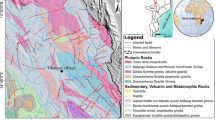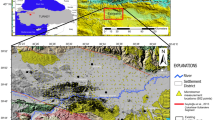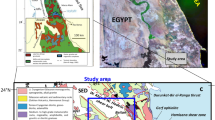Abstract
River management and restoration measures are of increasing importance for integrated water resources management (IWRM) as well as for ecosystem services. However, often river management mainly considers engineering and construction aspects only and the hydrogeological settings as the properties and functions of ancient fluvial systems are neglected which often do not lead to the desired outcome. Knowledge of the distribution of sediment units could contribute to a more efficient restoration. In this study, we present two noninvasive approaches for delineation of fluvial sediment architecture that can form a basis for the restoration, particularly in areas where site disturbance is not permitted. We investigate the floodplain of a heavily modified low-mountain river in Switzerland using different hydrogeophysical methods. In the first approach, we use data from electromagnetic induction (EMI) with four different integral depths (0.75–6 m) and gamma-spectrometry as well as the elevation data as input for a K-means cluster algorithm. The generated cluster map of the surface combines the main characteristics from multilayered input data and delineates areas of varying soil properties. The resulting map provides an indication of areas with different sedimentary units. In the second approach, we develop a new iterative method for the generation of a geological structure model (GSM) by means of various EMI forward models. We vary the geological input parameters based on the measured data until the predicted EMI maps match the measured EMI values. Subsequently, we use the best matched input data for the GSM generation. The derived GSM provides a 3D delineation of possible ancient stream courses. A comparison with an independent ground penetrating radar (GPR) profile confirmed the delineations on the cluster map as well as the vertical changes of the GSM qualitatively. Thus, each of the approaches had the capacity for detecting sedimentary units with distinct hydraulic properties as an indication of former stream courses. The developed methodology presents a promising tool for the characterization of test sites with no additional subsurface information.









Similar content being viewed by others
References
Abdu H, Robinson DA, Seyfried M, Jones SB (2008) Geophysical imaging of watershed subsurface patterns and prediction of soil texture and water holding capacity. Water Resour Res 44
Altdorff D, Dietrich P (2012) Combination of electromagnetic induction (EMI) and gamma-spectrometry using K-means clustering: a study for evaluation of site partitioning. J Plant Nutr Soil Sci. doi:10.1002/jpln.201100262
Anderson WL (1979) Numerical integration of related Hankel transforms of orders 0 and 1 by adaptive digital filtering. Geophysics 44:1287–1305. doi:10.1190/1.1441007
Bierwirth P, Gessler P, McKane D (1996) Empirical investigation of airborne gamma-ray images as an indicator of soil properties Wagga Wagga, NSW. AGSO record
Brierley GJ, Frvirs K (2000) River styles, a geomorphic approach to catchment characterization: implications for river rehabilitation in Bega Catchment, New South Wales. Australia. Environmental Management 25(6):661–679
Brierley GJ, Frvirs K (2005) Geomorphology and river management: applications of the river styles framework. Blackwell Publishing, Oxford, p 398
Brierley GJ, Frvirs K (2008) River futures: an integrative scientific approach to river repair. Island Press, Washington, p 328
Brocca L, Melone F et al (2009) Soil moisture temporal stability over experimental areas in Central Italy. Geoderma 148(3–4):364–374
Buwal/BWG (Hrsg) 2003 Leitbild Fliessgewässer Schweiz, Für eine nachhaltige Gewässerpolotik. Bern, 12 Seiten
CEN—European Committee for Standardization (2011) Best practice approach for electromagnetic induction measurements of the near surface, approved business plan, CEN workshop 59
Chow JJ, Chang SK, Yu HS (2006) GPR reflection characteristics and depositional models of mud volcanic sediments—Wushanting mud volcano field. Southwestern Taiwan JOURNAL OF APPLIED GEOPHYSICS 60(3–4):179–200
City of Willisau (2008) Averaging flow rate measured on 13th November 2008 during a construction project in Willisau/Canton Luzern/Switzerland
Cockx L, Van Meirvenne M, De Vos B (2007) Using the EM38DD Soil sensor to delineate clay lenses in a sandy forest soil. Soil Sci Soc Am J 71(4):1314–1322
Darnley AG, Ford KL (1987) Regional airborne gamma-ray surveys: a review. In: Garland GD (ed) Exploration ’87. Third Decennial International Conference on Geophysical and Geochemical Exploration for Minerals and Groundwater, special volume 3. Geological Survey of Canada, Ontario, Canada, pp. 229–240
Di Prinzio M, Bittelli M, Castellarin A, Pisa PR (2010) Application of GPR to the monitoring of river embankments. J Appl Geophys 71(2–3):53–61
Dietrich P, Tronicke J (2009) Integrated analysis and interpretation of cross-hole P- and S-wave tomograms: a case study. Near Geophysics 7(2):101–109
Dietrich P, Fechner Th, Whittaker J, Teutsch G (1998) A intergated hydrogeophysical approach to surface characterization. In: Herbert M, Kovar K (eds) Groundwater quality: remediation and protection. IAHS Publication, 250. ISSN:0144-7815:513-520
Djadia L, Machane D, Chatelain JL, Abtout A, Bensalem R, Guemache MA, Guillier B, Boudella A, Oubaiche EH (2010) Evidence for an underground runoff and soil permeability at the Ouled Fayet (Algiers, Algeria) subsurface landfill pilot project from geophysical investigations. Environmental Earth Sciences 59(5):1149–1158
Elwaseif M, Ismail A, Abdalla M, Abdel-Rahman MM, Hafez MA (2012) Geophysical and hydrological investigations at the west bank of Nile River (Luxor, Egypt). Environmental Earth Sciences 67(3):911–921
Geographical Dictionary Switzerland (1910) http://www.swisstopo.admin.ch. Accessed Aug 2011
Gerber ME, Kopp J (eds) (1994) Landeshydrologie und Geologie, Geologischer Atlas der Schweiz, map sheet 1129: Sursee
Gilbert JM, Warner BG, Aravena R, Davies JC, Brook D (1999) Mixing of floodwaters in a resorted habitat wetland in northern Ontario. Wetland 19(I):106–117
Hedley CB, Yule IJ, Eastwood CR, Shepherd TG, Arnold G (2004) Rapid identification of soil textural and management zones using electromagnetic induction sensing of soils. Aust J Soil Res 42:389–400
Huggenberger P, Meier E (1993) Anwendung des Georadars in der Hydrogeologie: Erkennung von Inhomogenitäten im Hinblick auf eine quantitative Beschreibung von Stofftransportprozessen. Wasser, Energie, Luft 5–6:119–123
Huisman JA, Hubbard SS, Redman JD, Annan AP (2003) Measuring soil water content with ground penetrating radar: a review. Vadose Zone Journal 2:476–491
International Atomic Energy Agency (2003) Guidelines for radioelement mapping using gamma ray spectrometry data. ISBN:92–0–108303–3
Irvin BJ, Ventura SJ, Slater BK (1997) Fuzzy and isodata classification of landform elements from digital terrain data in Pleasant Valley, Wisconsin. Geoderma 77:137–154
Jähnig CK, Brabec A, Erba S, Lorenz AW, Ofenböck T, Verdonschot PFM, Hering D (2010) A comparative analysis of restoration measures and their effects on hydromorphology and benthic invertebrates in 26 central and southern European rivers. J Appl Ecol 2010(47):671–680
Keller GV, Frischknecht FC (1966) Electrical methods in geophysical prospecting. In: International series of monographs in electromagnetic waves 10. Pergamon Press, Oxford
Kronvang B, Hoffmannand CC, Dröge R (2009) Sediment deposition and net phosphorus retention in a hydraulically restored lowland river floodplain in Denmark: combining field and laboratory experiments. Mar Freshw Res 2009(60):638–646
Lambot S, Weihermüller L, Huisman JA, Vereecken H, Vanclooster M, Slob EC (2006) Analysis of air-launched ground-penetrating radar techniques to measure the soil surface water content. Water Resour Res 42:W11403. doi:10.1029/2006WR005097
Larsen LG, Harvey JW (2011) Modeling of hydroecological feedbacks predicts distinct classes of landscape pattern, process, and restoration potential in shallow aquatic ecosystems. Geomorphology 126(3–4):279–296
Lavoué F, van der Kruk J, Rings J, Andre F, Moghadas D, Huisman JA, Lambot S, Weihermüller L, van der Borght J, Vereecken H (2010) Electromagnetic induction calibration using apparent electrical conductivity modelling based on electrical resistivity tomography. Near Surface Geophys. 8:553–561
Lennox MS, Lewis DJ, Jackson RD, Harper J, Larson S, Tate KW (2011) Development of vegetation and aquatic habitat in restored riparian sites of California’s north coast rangelands. Restor Ecol 19(2):225–233
Linde NI, Coscia JA Doetsch, Greenhalgh SA, Vogt T, Schneider P, Green A (2010) Hydrogeophysical studies in unrestored and restored river corridors of the Thur River, Switzerland. First Break 28:69–75
Liu LB, Li Y, Zhou CG (2000) Identification of paleo-liquefaction and deformation features with GPR in the New Madrid seismic zone GPR 2000 In: proceedings of the eight international conference on ground penetrating radar. Book series: proceedings of spie—the international society for optical engineering V. 3380, pp 383–389
MacQueen J (1967) Some methods for classification and analysis of multivariate observations. In: Le Cam LM, Neyman J (eds) Proceedings of the fifth Berkeley symposium on mathematical statistics and probability, vol 1, pp 281–297
Martinez G, Vanderlinden K, Espejo A, Muriel JL (2010) Field-scale soil moisture patter mapping using electromagnetic induction. Vadose Zone J. 9:871–881
McArthur SAQ, Allen DM, Luzitano RD (2011) Resolving scales of aquifer heterogeneity sing ground penetrating radar and borehole geophysical logging. Environ Earth Sci 63(3):581–593
McNeil JD (1980) Electromagnetic terrain conductivity measurement at low induction numbers. Geonics. Ltd., technical note TN-6
Mester A, van der Kruk J, Zimmermann E, Vereecken H (2011) Quantitative two-layer conductivity inversion of multi-configuration electromagnetic. Induction Measurements Vadose Zone Journal 10:1319–1330
Mika S, Hoyle J, Kyle G, Pusey B, Spencer J, Spink AM (2010) Inside the “black box” of river restoration: using catchment history to identify disturbance and response mechanisms to set targets for process-based restoration
Nanson GC, Croke JC (1992) A genetic classification of floodplains. Geomorphology 4:459–486
Paasche H, Tronicke J, Dietrich P (2010) Automated integration of partially collocated models: subsurface zonation using a modified fuzzy c-means cluster analysis algorithm. Geophysics 75(3):11–22
Porsani JL, Filho WM, Elis VR, Shimeles F, Dourado JC, Moura (2004) HP the use of GPR and VES in delineating a contamination plume in a landfill site: a case study in SE Brazil. J Appl Geophys 55(3–4):199–209
Pracilio G, Adams ML, Smettem KRJ, Harper RJ (2006) Determination of spatial distribution patterns of clay and plant available potassium contents in surface soils at the farm scale using high resolution gamma ray spectrometry. Plant Soil 282:67–82
Robinson NJ, Rampant PC, Callinan APL, Rab MA, Fisher PD (2009) Advances in precision agriculture in south-eastern Australia. II. Spatio-temporal prediction of crop yield using terrain derivatives and proximally sensed data. Crop Pasture Sci 60:859–869
Robinson DA, Abdu H, Lebron I, Jones SB (2012) Imaging of hill-slope soil moisture wetting patterns in a semi-arid oak savanna catchment using time-lapse electromagnetic induction. J Hydrol 419–417:39–49
Rohde S, Kienast F, Bürgi M (2004) Assessing the restoration success of river windenings: a landscape approach. Environ Manage 34(4):574–589
Sandmeier Software (2010). http://www.sandmeier-geo.de/. Accessed Aug 2011
Santos RNS, Porsani JL (2011) Comparing performance of instrumental drift correction by linear and quadratic adjusting in inductive electromagnetic data. J Appl Geophys 73:1–7
Sholtes JS, Doyle MW (2011) Effect of channel restoration on flood wave attenuation. J Hydraulic Eng 137(2):196–208
Sivirichi GM, Kaushal SS, Mayer PM, Welty C, Belt KT, Newcomer TA, Newcomb KD, Grese MM (2011) Longitudinal variability in streamwater chemistry and carbon and nitrogen fluxes in restored and degraded urban stream networks. J Environ Monit 13:288–303
Steelman CM, Endres AL (2009) Evolution of high-frequency ground-penetrating radar direct ground wave propagation during thin frozen soil layer development. Cold Reg Sci Technol 57:116–122
SYSTAT Software (2007) Product information. San Jose SYSTAT Software, Inc. www.systat.com. Accessed July 2011
Taylor MJ, Smettem K (2002) Relationships between soil properties and high-resolution radiometrics, central eastern Wheatbelt, Western Australia. Explor Geophys 33(2):95–102
Trexler JC (1995) Restoration of the Kissimmee River: a conceptual model of past and present fish communities and its consequences for evaluation restoration success. Restor Ecol 3(3):195–210
Triantafilis J, Lesch SM (2005) Mapping clay content variation using electromagnetic induction techniques. Computers and Electronics in Agriculture 46:203–237
Tsabaris C, Kapsimalis V, Eleftheriou G, Laubenstein M, Kaberi H, Plastino W (2012) Determination of Cs-137 activities in surface sediments and derived sediment accumulation rates in Thessaloniki Gulf Greece. Environmental Earth Sciences Volume 67(3):833–843
van der Krug J, Meekes JAC, Van Den Berg PM, Fokkema JT (2000) An apparent-resistivity concept for low-frequency electromagnetic sounding techniques. Geophyiscal Prospecting 48:1033–1052
Viscarra Rossel RA, Taylor HJ, McBratney A (2007) Multivariate calibration of hyperspectral γ-ray energy spectra for proximal soil sensing. Eur J Soil Sci 58(1):343–353
Wagner W, Pathe C, Doubkova M, Sabel D, Bartsch A, Hasenauer S, Blöschl G, Martinez-Fernandez J, Loew A (2008) Temporal stability of soil moisture and radar backscatter observed by the advanced synthetic aperture radar (ASAR). Sensors 8:1174–1197
Wait J (1982) Geo-electromagnetism. Academic Press, New York
Ward SH, Hohmann G (1988) In: Nabighian MN (ed) Electromagnetic theory for geophysical applications, vol 1. Society of Exploration Geophysicists
Weller U, Zipprich M, Sommer M, Zu Castell W, Wehrhan M (2007) Mapping clay content across boundaries at the landscape scale with electromagnetic induction. Soil Sci Soc Am J 71:1740–1747
Wohl E (2010) Compromised rivers: understanding historical human impacts on rivers in the context of restoration. Restoration. Ecology and Society 10(2):2
Wong MTF, Harper RJ (1999) Use of on-ground gamma-ray spectrometry to measure plant-available potassium and other topsoil attributes. Aust J Soil Res 37:267–277
Wong MTF, Asseng S, Oliver Y (2008) Mapping subsoil acidity and shallow soil across a field with information from yield maps, geophysical sensing and the grower. Precision Agric 9:3–15
Acknowledgments
The authors thank Marek Mahn for the technical help during the SYNDATA modification, Simon Kögler for his support during the field work and Steffen Zacharias for his constructive help concerning statistical questions. The authors also acknowledge the Helmholtz research platform MOSAIC for providing the technical equipment.
Author information
Authors and Affiliations
Corresponding author
Rights and permissions
About this article
Cite this article
Altdorff, D., Epting, J., van der Kruk, J. et al. Delineation of fluvial sediment architecture of subalpine riverine systems using noninvasive hydrogeophysical methods. Environ Earth Sci 69, 633–644 (2013). https://doi.org/10.1007/s12665-013-2304-4
Received:
Accepted:
Published:
Issue Date:
DOI: https://doi.org/10.1007/s12665-013-2304-4




